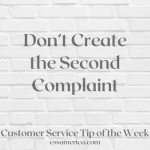
The 3rd grade teacher had a phrase she used with her students. She wanted them to be “kind-hearted.” It was a phrase she used over and over again; no matter what she taught, this was an overriding emphasis on how she would communicate with students and how she expected them to communicate with each other.
Yet, in 2020, it seems like a lot of the dialogue, at least publicly, is anything but kind. And where there is a lack of kindness in public discourse, kindness in 1-on-1 communications is needed that much more. Sometimes people in customer service can be so script-oriented, so ultra-professional, so technique-oriented, that having a little bit of informality – that little extra kindness needed to treat a person like a person – can get lost.
So, what is kindness? It’s being friendly, conversational. It’s being nice in the words and phrases that are used. To be nice, think about what is said and the tone that is used. Avoid the interruption or talking over the other person. Ask about the other person and how they are doing, what is of interest to them.
It’s being considerate of the other person’s time and situation. Their concern or priority may not seem like a big deal to you, but if this is a need or concern being voiced by the customer, it is obviously a big deal to them.
Have a gentle manner. Sometimes we can be so loud or so abrupt that even the best words can come across like a hammer. Keep the tone lower and the pace a tiny bit slower.
People who are kind understand how to listen, and the importance of making sure that most of the talking is done by the other individual. They understand that being perceived as empathetic is best achieved if the customer feels like you are listening enough to understand them. You’re asking enough questions to learn. You’re actually conveying you care more by commenting less.
If you’re looking for a way to bring a little brighter experience to your customer’s day, figure out how to add more kindness to your conversations. The customers will appreciate the break from the acrimony of their day with the kindness you bring into the conversation.
Customers will appreciate your kindness.
Signup for FREE Tips! Contact Us More Resources for You Visit Our Home Page















 The IT helpdesk representative was on a call with a customer, and in trying to troubleshoot an issue, the employee said, “Let’s start by opening Windows.” The customer said “OK,” and there were 2 minutes of silence. The employee twice asked, “Are you still there?” with no response. Finally, the customer got back on the phone and said, “Sorry about that; two of my windows were easy to open, but the third was painted shut.”
The IT helpdesk representative was on a call with a customer, and in trying to troubleshoot an issue, the employee said, “Let’s start by opening Windows.” The customer said “OK,” and there were 2 minutes of silence. The employee twice asked, “Are you still there?” with no response. Finally, the customer got back on the phone and said, “Sorry about that; two of my windows were easy to open, but the third was painted shut.”






